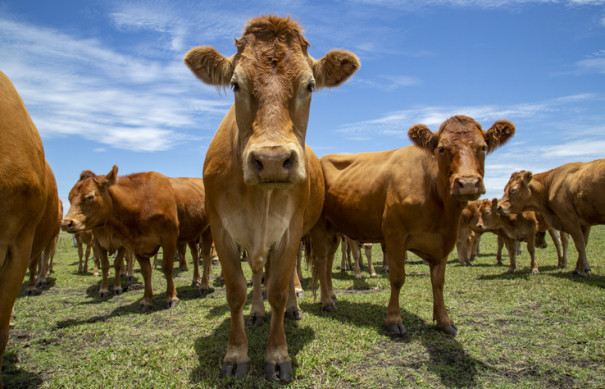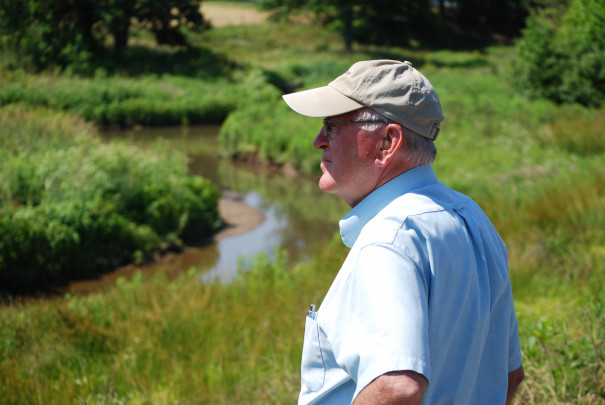5 Common Myths About Beef Sustainability, Busted by a Philly Farmer

Few things symbolize summertime quite like a backyard BBQ. Whether you’re grilling juicy burgers or sizzling steaks, the sweet, smoky smell and tender taste of fresh-cooked beef are a feast for the senses and quintessential to the season. The best part? It’s not just the mouthwatering flavors you can feel good about, but where the beef comes from, too.
The words “beef” and “sustainability” may not seem to go together at first. Misinformation and misconceptions about the impact of beef production on the environment often make beef out to be the bad guy. So, to get the truth about beef sustainability, we figured it would be best to go straight to a local source: Masonic Villages Farm, a cattle ranch in Elizabethtown. The 500-acre, 160 cow operation is considered a pioneer in the industry, garnering numerous environmental stewardship awards for its innovative farming practices driven by an eco-friendly mission.

“Sustainability is always on the forefront of our minds,” says farm manager Scotty Miller. “If we don’t take care of the land, it won’t take care of us.”
As a beef cattle farming expert, we asked Miller to illuminate just what kind of an impact beef has on the environment. The answer may surprise you. Here are the five most common myths he hears about the sustainability of beef, busted.
Myth #1: Cattle are a top producer of greenhouse gas emissions.
It’s no secret that cows burp a lot. Due to a diet of plants that ferment in their stomachs, those burps contain methane, a greenhouse gas. Here’s the thing. Cow belches only account for two percent of direct emissions in the U.S. and unlike carbon monoxide, the methane produced gets recycled out of the atmosphere back into the ground in about 12 years. Miller also points out that once the methane is back in the ground and converted to CO2, the plants the cows eat can use it again for photosynthesis, creating a sustainable cycle. “That’s going to pull in carbon dioxide and release more oxygen,” says Miller.
Myth #2: Cows compete with humans for food.
You’re probably not going to want to eat what cows eat. In fact, most of it you can’t. More than 90% of a cow’s diet is forage and plant leftovers that would otherwise go to waste. Sure, cows are big corn lovers, but corn used to feed grain-finished beef cattle still only represents only 7% of harvested corn in the entire U.S. Cows also do something pretty remarkable with all that indelible food. They upcycle it into high-quality protein packed with healthy vitamins and minerals, more than three times as much as they consume, contributing to better food security.
“Instead of going to a landfill, cows can take food waste that isn’t suitable for anything else and basically turn it into a really sweet product called beef,” says Miller.

Myth #3: Cattle degrade the land.
Cattle grazing and upcycling don’t just produce healthy beef. It also enhances the natural ecosystem by converting indigestible plant fiber into protein while cycling nutrients through the soil—not to mention all those nutrients provided by cow manure. Those grazing lands in turn do wonders for water regulation and purification, carbon sequestration, and wildlife habitat valued at nearly $25 billion. Not bad for spending all day munching on grass. “Cows utilize areas that might not be suited for anything else,” says Miller. In fact, about 29% of the land in the U.S. isn’t suitable for growing food crops, but it’s perfect for cattle.
Myth #4: Beef has an enormous water footprint.
300 gallons. That’s roughly the amount of water the average American family uses in their home each day. It’s also about the same amount of water—308 gallons, the vast majority of which is naturally occurring rainfall—it takes to produce a pound of boneless beef, far less than the 24,000 gallons (or 50 baths) that may have been true decades ago, but is no longer the case thanks to much improved modern beef production. Sure, that may still sound like a lot, but compared to other products—713 gallons of water to make a t-shirt, for example—beef isn’t quite the water guzzler it’s made out to be. “When you compare it to how much humans use a day, it’s actually not that much,” says Miller.

Myth #5: Beef comes from factory farms.
Miller isn’t the only farmer driven by sustainability. More than 90% of cattle farms nationwide are family-owned and operated and agree with Miller that producing a healthy product requires maintaining a healthy environment. That’s why most beef farmers voluntarily partake in the Beef Quality Assurance program to learn best practices for animal care and nutrition. Many farms are also heavily engaged in their communities beyond just providing quality beef. Masonic Village Farm is also a non-profit retirement community devoted to conservation and ensuring residents continue to enjoy open spaces. The public is also welcome to tour the farm facilities to learn more about beef sustainability and environmental stewardship.
No matter how you slice it, the story of how beef gets to your BBQ is much more sustainable than you might of heard. Thanks to farmers like Miller, you can feel good about where your beef comes from next time you take another bite of a juicy ribeye. “We take blue skies and green grass and make red meat,” says Miller. Time to fire up the grill!
This is a paid partnership between National Cattlemen’s Beef Association, a contractor to the Beef Checkoff, in partnership with Landry Harlan of Philly Magazine’s City/Studio and Philadelphia Magazine